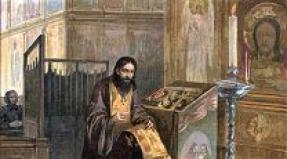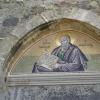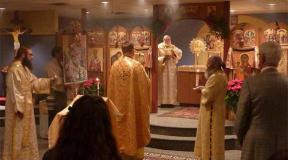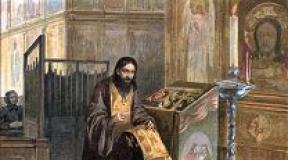Holy Apostle and Evangelist John the Theologian. Repose of the Apostle John the Theologian
─ holy evangelist and closest disciple of Jesus Christ. This date is one of the great holidays counted among the twelve, that is, somewhat inferior in importance to the twelve most important celebrations after Easter, but, nevertheless, important milestones of the annual liturgical cycle.
Sons of Thunder
From the pages of the New Testament and from the Holy Tradition it is known that the father of the Evangelist John was a simple fisherman named Zavedei, and his mother was the daughter of the righteous John the Betrothed from his first marriage, Salome. On the day of remembrance of the Apostle John the Theologian, it is always mentioned that he is one of the first disciples of Jesus Christ, called by him to serve.
This event took place on the shore of Lake Gennesaret, when John, together with his brother Jacob, helped his father in his work. At the call of the Savior, the young people left their previous occupations forever and followed Him.
The Holy Gospel of Mark says that Jesus loved both brothers very much and, for their irrepressible, impetuous nature, called them the Sons of Thunder, which in Hebrew sounds like “Boanerges”. Following Christ throughout the entire path of his earthly ministry, they were witnesses and participants in many important events.
Witnesses of the Lord's miracles
Thus, on the day of memory of John the Theologian, gospel lines are read from church pulpits, which describe the Transfiguration of the Lord on Mount Tabor and emphasize that it is no coincidence that this miracle was revealed before the eyes of both sons of Zebedee. This expresses Jesus' special attitude towards to these three of his students.

In addition, on the day of memory of John the Theologian, passages from the 5th chapter of the Gospel of Mark and the 8th of Luke are certainly remembered, which tell about the resurrection of the daughter of Jairus, a very important person who headed one of the synagogues. This miracle, in which the will of the Lord forced the limits of human nature to expand, was also revealed before the eyes of the Apostle John.
Witness of the Passion of Christ
And not a single pastoral word on the day of memory of John the Theologian is complete without mentioning the Last Supper, at which, according to the Gospel texts, the holy apostle reclined next to Jesus Christ and, clinging to Him, asked a question about the name of the traitor who was among those present.
John did not abandon his Teacher even in his most tragic moments. The holy evangelists told the world how he accompanied the bound Christ when he was led to the house of the godless high priests Caiaphas and Annas. The Apostle John was also in the bishop’s courtyard on that cold spring night that preceded the bloody denouement.
He also followed the Savior throughout his path of the cross, and then, standing on the top of Golgotha, he mourned along with the Most Pure Mother of God. The highest manifestation of love for the disciple were the words of the Lord, in which from the height of the cross he commanded John the Theologian to continue to care for his mother, the care of whom from now on became his sacred duty, which he sacredly fulfilled until her dormition.

Sermons of the Apostle of Love
When the Most Holy Theotokos completed her earthly journey and the Lord lifted up her soul to his heavenly palaces, the Apostle John went with his disciple Prochorus to preach the word of God to the western coast of Asia Minor, to the city of Ephesus. From the book “Acts of the Apostles” it is known that during the sea voyage the ship on which John the Theologian was sailing was caught in a terrible storm, and only by the will of God he escaped death and on the fortieth day was washed ashore by a wave.
It also says that during the apostle’s sermons the Lord sent his signs and showed people various miracles, which helped even the most inexperienced to believe in Christ. Leaving Ephesus, the holy apostle left behind many converted Christians who united into a community that continued to grow in all subsequent years. The main idea of the sermons he preached throughout his ministry was the call to love, without which, as he taught, a person cannot approach his Creator. That is why John the Theologian is usually called “the apostle of love.”
Holy exile
When delivering a sermon on the day of memory of John the Theologian, pastors often recall episodes of his earthly journey that became known to us, as noted above, from the pages of the New Testament, as well as from the Holy Scriptures. In particular, speaking about the patronage that the Lord showed to his beloved disciple, they remember how the wicked pagans seized the apostle and took him to Rome, where they intended to put him to a cruel death. However, the all-merciful Creator saved him from the harmful effects of the poison that John was forced to drink, and from the boiling oil into the cauldron with which the executioners threw him.

Realizing their powerlessness before the servant of God, the Romans exiled him to the island of Patmos, the inhabitants of which were converted in large numbers to the Christian faith by the fiery sermons of the holy exile. The truth of the speeches he uttered was irrefutably evidenced by the many signs sent down by the Lord and the miracles shown to him through his preacher. Thus, there are many testimonies about the healing of the sick and the restoration of sight to the blind.
Prisoner of Patmos
Among the most significant acts, also mentioned on the day of memory of John the Theologian, is his expulsion of demons, which in large numbers filled the pagan temples built on the island. He also had to overcome the resistance of the servants of evil, one of whom was a sorcerer named Kinops. Whatever demonic tricks he resorted to, but by the grace of God and the power sent down to him through prayers, the holy righteous man prevailed over him, and the wicked man was cast into the depths of the sea, where he ended his days.
While serving his exile on Patmos, John the Theologian wrote one of the main works of the New Testament ─ the book “Revelation”, also known as “Apocalypse”. In it, guided by the inspiration of God, the apostle announced to people the secrets of the end of the world and the fate prepared for the Church. An illustration of the work of V. M. Vasnetsov is given below.

Return to Ephesus
When the days of his forced stay on the island finally ended, he returned again to where he continued to preach the doctrine of the resurrection of the son of God and in every possible way protect the inhabitants from the influence of false prophets, who flooded the country in large numbers and tried to take over their minds.
During the same period, the holy apostle wrote his famous Gospel, which was included in the books of the New Testament, as well as three conciliar messages, in which he explained a number of aspects of the new doctrine. Excerpts from these texts are also heard from church pulpits on the day of remembrance of the Apostle and Evangelist John the Theologian.
admonishing the lost
Saint John supported his preaching of love with concrete deeds. Thus, the Holy Tradition tells how, already in his old age, he became aware of one young man who had lost his way and became the leader of a gang of robbers. Leaving all his affairs and without hesitating for a minute, the apostle went in search of a young man who had embarked on the path of murder and doomed himself to eternal destruction.

The Lord directed his steps into the depths of the desert, where dashing robbers were hiding from their pursuers. It was difficult for the holy shepherd to reach the hearts of the villains, but, touched by his sincerity and love, they finally repented of what they had done and, together with their leader - the same young man about whom the Apostle John had heard - returned to a righteous life.
The end of the earthly journey
It is known that the Evangelist John was the only one destined to die a natural death. Sacred Tradition tells us about his death. It says that the earthly journey of the faithful servant of God lasted more than a hundred years, and at its completion he lay down in the grave and commanded the disciples to cover himself while still alive with earth (the illustration is given above).
Shedding tears and madly grieving, they nevertheless did not dare to contradict their mentor and carried out his will. When after some time Numerous followers of the apostle tried to rebury his remains and, for this purpose, opened the grave, but it turned out to be empty. This amazing fact gave rise to many the most contradictory interpretations among theologians of subsequent centuries.

Memory of the Holy Apostle
After three centuries, when the Christian faith, having emerged from underground, gained national status, a small church was erected on the spot where the Apostle John was once buried, and in the 6th century, under Emperor Justinian, a cathedral topped with six domes was built. To this day, only part of the floor slabs, several columns and fragments of walls have survived from this building (photo is given above).
Russian Orthodox Church celebrates the day of memory of John the Theologian on October 9, the anniversary of his death. In addition, sermons on May 21 and July 13, the feast of the twelve all-praised apostles of God, are dedicated to him. In Western churches, it is customary to celebrate the day of memory of John the Theologian (according to the new style) on December 27.
Holidays dedicated to the memory of saints are important for believers, since faithful prayer on such a day can save the soul and help in many situations. That is why on October 9 it is important to remember the day of remembrance of John the Theologian.
John the Theologian- a saint who, according to church tradition, is considered one of the 12 apostles of Jesus Christ. Several holidays are dedicated to this saint - May 21, July 13 and October 9. The last date is the day of the repose of John the Theologian, when the apostle left the earthly vale.
Prayer to John the Theologian in Church Slavonic:
O great and all-praised apostle and evangelist John the Theologian, confidant of Christ, our warm intercessor and quick helper in sorrows! Pray to the Lord God to grant us forgiveness of all our sins, especially those we have sinned from our youth, throughout our entire life, in deed, word, thought and all our feelings. At the end of our souls, help us, sinners, to get rid of airy ordeals and eternal torment, and through your merciful intercession we glorify the Father and the Son and the Holy Spirit, now and ever and unto ages of ages. Amen.
A few days after the day of the repose of John the Theologian, another important holiday is celebrated -. The cover symbolizes victory over evil and the power of the intercession of heaven, which protects righteous people from evil. We wish you peace in your soul, and if our publication was useful to you,don't forget to press the buttons and
08.10.2018 03:14
Every year Christians celebrate an important Orthodox festival - the Intercession of the Blessed Virgin Mary. The history and significance of this holiday...
During the celebration of Epiphany, Orthodox Christians collect water, which has unique properties. On the night of...
John the Theologian considered one of the most beloved and devoted students Christ, who preached the true faith until his death and relentlessly and faithfully followed the teacher all his life.
Life of the Apostle
John was the son fisherman Zebedee and one of the followers of Jesus Salome. Together with his older brother Jacob He was called by Christ to be one of His disciples and named “Son of Thunder” for his impetuous character.
According to the lot cast by all the Savior’s disciples, the apostle went to Ephesus (the territory of modern Turkey) for preaching purposes: thanks to him and his miracles, the number of believers increased every day.Roman Emperor Domitian Having learned about the destruction of the main Ephesian temple by a certain sorcerer, he ordered John to be seized, chained, beaten and then executed. The apostle was forced to drink poison, but it had no effect, he was thrown into a cauldron of boiling oil - John remained alive and unharmed. The emperor decided that John was immortal and sent him into exile on the island of Patmos, where he continued his preaching work and converted most of the local residents to Christianity.
Emperor Domitian was replaced Nerva, which did not interfere with the spread of Christianity, and John was released and returned to Ephesus. In subsequent years, he wrote the Gospel, in which he commanded Christians to love the Lord and each other, thereby fulfilling the law of Christ. That is why Saint John began to be called the apostle of love.
At the age of 95, John learned fromGentlementhat the days of his earthly life are numbered. Gathering his seven disciples before dawn, the apostle took them outside the city, prayed and asked them to dig up a grave in the shape of a cross, the length of his own height and, placing himself in it, ordered the disciples to “cover him with earth” up to his neck and leave. When the disciples, heeding the prayers of the Christians of Ephesus, led them to the grave, the apostle was not there. There is an opinion that the saint was taken to heaven along with his body, likeMother of Godand to the ancient righteous -Elijah And Enoch.
Icon “Apostle John the Theologian” (circa 1700), exhibition at the Museum of Russian Icon, 2011. Photo: RIA Novosti / Vladimir Vyatkin
In the Orthodox tradition, the Apostle John, along with Saint George And Simeon is called a “Theologian,” that is, an interpreter and defender of the doctrine of God, his activity in the world and revelation.
Miracles of John the Evangelist
One day, when John and his disciple were working in the Ephesian bathhouse, a certain young man died there, and after that his father also died of grief. The mistress of the bathhouse accused the apostle of murder, and then he resurrected both dead people.
While preaching, the crowd to which John was speaking stoned him, and he caused unbearable heat that killed 200 people. The crowd begged for mercy, and the apostle resurrected the dead.
On the way to the island of Patmos, the son of one of the royal nobles fell overboard and drowned. The next morning, John said a prayer, and a wave threw the young man onto the ship.
Thanks to the prayers of the apostle, the island of Patmos was freed from communication with unclean spirits Magus Kinops and his charms and atrocities.
Together with Peter And Jacob he was present at the resurrection daughters of Jairus, the transfiguration of Christ on Mount Tabor, the Lord’s prayer for the cup in the Garden of Gethsemane.
After the crucifixion of the Savior, he was the only one of the disciples who remained next to the Cross along with the Mother of God. Dying, Christ said that the Mother of God is the mother for John, and he becomes Her son. John took Blessed Virgin Mary to his home and took care of Her until Her Dormition.
He far outlived all the other eyewitnesses of the Lord and for a long time remained the only living witness to the earthly paths of the Savior.
How is the day of memory of John the Theologian celebrated?
On the day of the saint’s repose, you can attend a service in the church or at least visit the temple, read prayers to John the Theologian and light candles to his icon.Folk beliefs and signs
In the popular calendar, the day of St. John the Apostle is celebrated twice a year, calling Ivan of May the wheat worker, and Ivan of the Autumn the Theologian.
It is John who is considered the mentor of painting and icon painting: after all, he once turned a young man, herding geese, into a skilled painter, under his invisible patronage, handing him a letter of recommendation to the Constantinople court icon painter with a request to teach icon painting.
People say:
“If there is snow on the Theologian, then winter will fall on Michaelmas.”
*Michael's Day is the last autumn holiday in the folk calendar, associated with the end of the wedding season and celebrated on November 21.
After the death of Emperor Domitian, the Apostle John was returned from exile and came to Ephesus. There he was presented with three gospels, which he approved and, at the request of Christians, wrote his own gospel, complementing the other three. In his gospel, the Apostle John especially emphasizes the Divine nature of Christ, and therefore begins his book with the proclamation of the pre-worldly existence of God the Word. That is why the Apostle John received the title of Theologian. With his gospel, John also refuted the heresies that had arisen that denied the truth of the humanity of Christ. In addition, the apostle wrote three epistles in which he teaches Christians to abide in love and truth.
Walking around towns and villages, the Apostle preached the word of God everywhere. One day he converted a young man to Christ, whom he gave to the care of a bishop. He taught him the basics of faith, baptized him and left him to his will. The young man fell in with bad company and eventually became the chieftain of robbers. When John returned to the city, he demanded a report from the bishop. To this, the bishop said with tears that the young man died for God.
I found a good keeper for my brother! - John exclaimed. And, jumping on a horse, despite his extreme old age, he rode into the mountains to look for the chieftain. He, seeing him, rushed to run, and John rushed after him, promising him God's forgiveness.
The young man fell to the ground and repented. The Apostle kissed him and said that God had forgiven him. So John was looking for one lost sheep of the flock of Christ.
When the apostle had already reached a ripe old age, so that he was brought to church, then instead of long teachings he only said:
Children, love each other!
One day his disciples asked him why he repeated the same thing. John replied:
This is the commandment of the Lord, and if you keep it, then it is enough.
Having learned by the Spirit the day of his repose, John, saying goodbye to everyone, ascended with his closest disciples to the top of the hill. There they dug a shallow cross-shaped grave for him. Having kissed the disciples and blessed them, John lay down in the grave and ordered that it be covered with earth. Which is what they did. When other Christians found out about this, they dug up the burial, but did not find the body there. John was mysteriously taken from this world in the body, and he awaits the time of the end, when the prophecies revealed to him by God will be fulfilled.
And on the empty tomb in Ephesus, pink fragrant dust appeared every year, healing all who came.
Troparion, tone 2:
Apostle, beloved of Christ God, hasten to deliver people who are unrequited: they accept you as you fall, and those who have fallen on Persian are accepted, pray to Him, O Theologian, and disperse the present darkness of tongues, asking us for peace and great mercy.
Kontakion, voice 2:
Thy greatness, virgin, who is the story? Execute miracles, and pour out healings, and pray for our souls, as the Theologian and friend of Christ.
WRITING THE SACRED SCRIPTURES OF THE NEW TESTAMENT
Initially, the Church of Christ existed without Scripture. The Holy Spirit and the oral tradition of the apostles guided her. But soon the devil raised the false teachings of heretics against the Church, who began to distort Orthodox teaching, referring to their pseudo-gospels. Then the apostles, who did not want the Revelation of God to be perverted, and the true words of the Lord to be mixed with lies, wrote the four Gospels by the Holy Spirit. The first, eight years after the Ascension of the Lord, was the Gospel of Matthew. The Apostle Matthew wrote it for the Jerusalem Church in Hebrew, and later (10 years later) it was translated into Greek. Then, at the request of Roman Christians, the Apostle Mark recorded the sermons of the Apostle Peter. The Apostle Luke collected all the true traditions about Christ from eyewitnesses and wrote the Gospel for the newly converted Christian Theophilus (15 years after the Ascension), adding to it the book of the Acts of the Apostles. As mentioned above, all these gospels were approved by Christ's beloved disciple, John, who wrote his Gospel around the year 100. In addition, he wrote the book of Revelation (Apocalypse) and three letters to the Churches.
The apostles Peter (two), James, and Jude also wrote letters. - All these messages are called conciliar messages, i.e. universal. But the Holy Spirit wrote especially many letters through the Apostle Paul (14).
The chronology of the writing of the books of the New Testament is as follows:
Gospel of Matthew - 38
Gospel of Mark - 40
Gospel of Luke - 45
1 and 2 Epistle to the Thessalonians by the Apostle Paul - 51
Letters to the Philippians of the Apostle Paul - 56
Epistles 1 and 2 to the Corinthians, to the Galatians and to the Romans by him - 57.
The Epistles to the Colossians, Ephesians and Philemon of the Apostle Paul and the 1st Epistle of the Apostle Peter - c. '62
Acts of the Apostles and the Epistle of the Apostle James - 63
1 Epistle to Timothy and Epistle to Titus of the Apostle Paul - ca. '65
Epistles of the Apostle Paul: Hebrews, 2 Timothy, 2 Epistle of the Apostle Peter - 67
Epistle of the Apostle Jude - ca. '68
Three Epistles of the Apostle John - 80s
Revelation - 95
Gospel of John - ca. 100 years.
For several centuries, the Church, guided by the Holy Spirit, carefully selected these messages, separating them from fakes and forgeries. The final canon of the Holy Scriptures of the New Testament was adopted at the Council of Carthage in 419 and the Council of Constantinople in 692.
ERA OF MARTYRS
Already in the time of the holy apostles, the three-century era of martyrs began, the great witnesses of the glorious victory of Christ over death. As the Holy Spirit said to the Apostle John, “The devil will cast you from among you into prison to tempt you, and you will have tribulation for ten days.”(Rev. 2:10). Indeed, starting with the persecutions of Emperor Nero, there are about ten persecutions that engulfed the Church.
13. The first persecution - Emperor Nero 64-67, when most of the apostles were executed.
14. Under Emperor Domitian - 91
15. Under Trajan - 98–107.
16. Marcus Aurelius - 177
17. Septimius Severus - 202
18. Emperors Decius and Gallus - 250–252.
19. Valerian - 257
20. Aurelian - 275
21. Diocletian - 304
22. Maximian - 311
Our Lord Himself indicated the spiritual reason for the persecution, saying: “If you were of the world, the world would love its own; But because you are not of the world, but I chose you out of the world, therefore the world hates you... They will drive you out of the synagogues; the time even comes when everyone who kills you will think that he is serving God. They will do this because they have not known either the Father or Me.”(John 15:19; 16:2–3). Christians for the world community are something alien, foreign. They are like a thorn in the flesh. People living according to passions feel in the disciples of the Risen One a living reminder of the heavenly Fatherland, which they rejected for the sake of the earthly kingdom, and therefore begin to persecute them with hatred, thereby wanting to destroy the voice of God in their hearts. Their master, the devil, knowing that he has little time left, is furiously pursuing Christians, wanting to drag as many of God’s creatures as possible into eternal destruction with him. Moreover, paganism, being destroyed by the Church, is Satan’s favorite patrimony, where he and his servants received service under the names of gods. He doesn’t want to lose his slaves who worship him. Therefore, until the very end of the world, the Church will be persecuted, until Christ comes and frees us, and all enemies will be thrown at the feet of the Lord.
The external reason for the three-century persecution of the Church is the accusation of rejecting the state cult, preaching a new non-traditional religion and thereby undermining society itself.
An excellent example of the argumentation of pagan accusers is a quotation from the martyrdom of the martyr Carp (his memory is October 13). Governor Valery, admonishing the martyrs, said: “It is not unknown to you, I think, that glory and honor have been given to the immortal gods since ancient times, and this remains so to this day, not only among us who know the Greek and Roman languages, but also among the barbarians ; for through zeal for the gods, cities are governed by good laws, victories are won over enemies and peace is strengthened... Honor them too. And if, through the words of ignorant people, you were seduced by the unreasonable and recently appeared Christian faith, then come to your senses now and return to what is better. Then the gods will have mercy on you, and you will enjoy the many blessings that we have; Great mercies await you from the Tsar” (Lives of the Saints of St. Demetrius of Rostov. October).
So, for pagans, an indication of the good quality of any religion was its antiquity, the degree of distribution, and the conviction that a true religion should maintain the strength of the state and ensure material well-being for its adherents. Christianity was for them a dangerous anti-state sect, not loyal to the government (because it rejected the deification of emperors).
Usually no one protested against the worship of Christ as God. Christians were required to be tolerant of other faiths and to show politeness towards the state gods. But for the Lord’s disciples it was unthinkable to worship the statues, knowing that the forces of evil lurk in them, just as it was impossible to respect an obvious lie. Moreover, the members of the Church knew that the price of this lie and even the simplest burning of incense in front of the idol was eternal death. Therefore, every martyr executed for the name of Christ is not a victim of tragic circumstances, but a great conqueror of Satan and all lies. It is not without reason that, in the exact words of the ancient defender of Christianity Tertullian, “the blood of martyrs is the seed of the Church.”
Another reason for the persecution was persecution and denunciations from the Jews who rejected their Messiah. They began persecution of the Church in Jerusalem, they also initiated many persecutions of Christians in the Roman Empire, and even after the victory of Christianity, their hatred of the Crucified Lord did not decrease. Suffice it to recall the terrible events of 614, when, after the capture of Jerusalem by the Iranian Shah Khozroe, Jewish merchants specifically ransomed Christians in order to kill them. This happened because the Jewish people forgot the Creator for the sake of the earth. It is not without reason that immediately after the rejection of Christ, the faith of the prophets begins to degenerate so that it becomes indistinguishable from paganism. - The doctrine of the transmigration of souls, magic, the pantheistic doctrine of the origin of the world from the essence of God, and pagan concepts about the racial difference of Jews from other people penetrate into Judaism. Therefore, the news of the true Messiah, who fulfilled all the dreams of the prophets and saved all people, and not just the Jews, turned out to be unthinkable for the apostates.
The holy martyrs destroyed all these godless delusions with their feat. As the Hieromartyr Cyprian of Carthage, who himself became a martyr, wrote, martyrdom “is the foundation of life and faith, it is the support of salvation, the union of freedom and honor... The glory of the martyrs is priceless, boundless greatness, bright victory, famous dignity, priceless name, endless triumph; because, as it were, the very blood of Christ adorns the one who is glorified by the holy confession” (Book of Praise of Martyrdom to Moses, Maximus and Other Confessors).
Therefore, it is much more important for us to know the inner disposition of the martyrs than to see all the evil plans of the enemy. After all, martyrs are citizens of heaven, heirs of Christ. Their very feat is an example of Christian holiness.
John the Theologian, or John Zebedee, is one of the Twelve Apostles. In the Christian tradition, he is the author of his Gospel, the Book of Revelation and three messages that are included in the New Testament.
The Day of the Apostle John the Theologian is celebrated in Orthodox and Lutheran, as well as in some Protestant churches. The memory of the Apostle John in Orthodoxy according to the Julian calendar is May 8 (21), June 30 (the Council of the Twelve Apostles is celebrated), September 26 (repose). And in the Catholic Church and other churches in the West - December 27.
The Revelation of John the Theologian speaks of 4 animals that are at the throne of God in heaven and constantly praise the Lord. They look like a lion, a bull, an eagle, and the fourth has the face of a man. In this regard, each of the 4 authors of the Gospel received its own symbol in the Christian tradition, often depicted in paintings. The symbol of the Apostle John was the eagle.
In the New Testament
The holy apostle and creator of the Gospel John the Theologian was born into the family of Zebedee and Salome. According to legend, Zebedee is the daughter of the saint. She is mentioned among the wives who served the Lord with their property. The Apostle James is his elder brother. A simple fisherman became one of the disciples of Jesus Christ on Lake Gennesaret: on the lake both brothers left Zebedee, their father, in a boat and went after Christ (Matthew 4:21; Mark 1:19).
In the Gospels, the brothers James and John are called the sons of Zebedee, taking as a basis the name of their father; Evangelist Mark also confirmed this (Mark 3:17). Jesus called the brothers Boanerges (an Aramaic word that stands for "sons of thunder" in the New Testament) because of their impetuous nature, which was on full display when:
According to the Gospel narratives, John, together with his older brother James, had a close relationship with the Apostle Peter and, together with the Apostle Peter, were disciples who were brought close by the Lord. The three of them became eyewitnesses to the resurrection of Jairus’s daughter (Mark 5:37; Luke 8:51), and only they Jesus allowed to become witnesses of his Transfiguration (Matthew 17:1; Mark 9:2; Luke 9:28) and Gethsemane prayer (Mark 14:33).
On the Cross, Jesus asked John to take care of His Mother, the Virgin Mary.
John was mentioned in the lists of the apostles in the Gospel of Matthew (Matthew 10:2), Mark (Mark 3:17), Luke (Luke 6:14), as well as in the Acts of the Apostles (Acts 1:13 ).
Writings of an Apostle in the New Testament
According to tradition, the apostle is credited with creating 5 books of the New Testament:
1. Gospel of John
2. First Epistle of John
3. Second Epistle of John
4. Third Epistle of John
5. Revelation of John the Theologian (Apocalypse).
The apostle received the name John the Theologian because Jesus Christ in the Gospel of John was called the Word of God.
Future life
The subsequent life of the apostle can only be learned from church traditions.
Missionary path
The legend describes that after the Dormition of the Mother of God, the Apostle John was given a lot, and he went to Ephesus and other cities of Asia Minor to preach the Gospel. He was accompanied by his student Prokhor.
In Ephesus, the Apostle John did not stop preaching to the pagans about Christ. And his preaching was accompanied by numerous and great miracles, so the number of believers constantly increased.
When Emperor Nero began persecuting Christians, the Apostle John was taken in prison to trial in Rome and sentenced to death for preaching his ardent faith in Jesus Christ. However, having drained the cup of deadly poison offered to him, he did not die. And he emerged from the cauldron of boiling oil completely unharmed. After the failed execution, the apostle was exiled to prison on the island of Patmos, where he lived for many more years.
In reference to Fr. Patmos
The life says that when John appeared on the island of Patmos, his preaching and the miracles he performed attracted all the inhabitants of the island to him: he converted almost every one of them to Christianity, cast out demons from pagan temples and healed many sick people.
On the island of Patmos, the Apostle John, taking with him his disciple Prochorus, went to a deserted mountain and read prayer there for 3 days, and also kept a fast. After this, the cave in which they lived began to shake and thunder roared. In fear, Prokhor threw himself to the ground. The Apostle picked him up and told him to write down his next words: “In the beginning was the Word, and the Word was with God, and the Word was God...”. Over the course of 2 days and 6 hours, Prokhor recorded the Gospel that was given to the apostle. After John and Prokhor came to the village, the Gospel was rewritten and distributed throughout the island. Some time later, John again withdrew into a cave, where he spent 10 days without food in prayer. When he was about to leave the cave, a voice said to him: “John, John!” The apostle responded to him: “What, Lord!” And it is said: “Create another ten days in the cave and many great secrets will be revealed to you in this place.” John obeyed and spent another ten days in the cave, praying and eating nothing. And then he saw great powers and an angel of God, who explained to him everything that he had seen and heard. After this, he called Prokhor and told him: “What you hear from my lips, write down on paper.”
Return
After a long exile on the island of Patmos, the Apostle John received freedom and returned to Ephesus. There he continued to teach Christians to guard against emerging heresies. When he was somewhere between 85 and 95 years old, the Apostle John in Ephesus decided to write down the Gospel. He commanded all Christians to love the Lord and each other. In this way they fulfilled the law of Jesus Christ. Saint John is the Apostle of love, as he taught that without love a person will not become closer to God and will not please Him. In 3 of his Epistles, the Apostle John preaches love for God and neighbors, himself being an example of love for those around him.
We can only say approximately about the years of life of the Apostle John. The Church says that he saw the crucifixion of Christ at the age of 16, and he passed away in the 100th year, being the only living apostle who saw Jesus Christ during His earthly life. That is, he lived somewhere from 17 to 100. AD
All the other apostles at this time had already suffered martyrdom. The entire Christian church greatly revered the Apostle John, since he was the seer of the destinies of God. On the icons, the Holy Apostle John is depicted with an eagle, which symbolizes the high soaring of his theological thought.
His disciple Ignatius the God-Bearer, who was the third Bishop of Antioch after the Apostle Peter and Evoda and was given to the lions on December 20, 107 in Rome, also wrote about the personality of John the Theologian.
It is believed that the last person who saw the living Christ was Ignatius the God-Bearer, who outlived John the Theologian by 7 years. According to legend, he received his nickname because Jesus took him in his arms as a child (Gospel of Matthew, 18:2-5).
Raising the Dead by the Apostle
According to the life of the apostle, the following cases of his resurrection from the dead took place:
Read also...
- Venerable Nile the Myrrh-streaming River and his prophecies about the final destinies of our world
- Repose of the Apostle John the Theologian
- John the Theologian: The Repose of the Apostle John the Theologian - victory over corruption
- Certificate 2 personal income tax was not accepted by the tax authorities


















